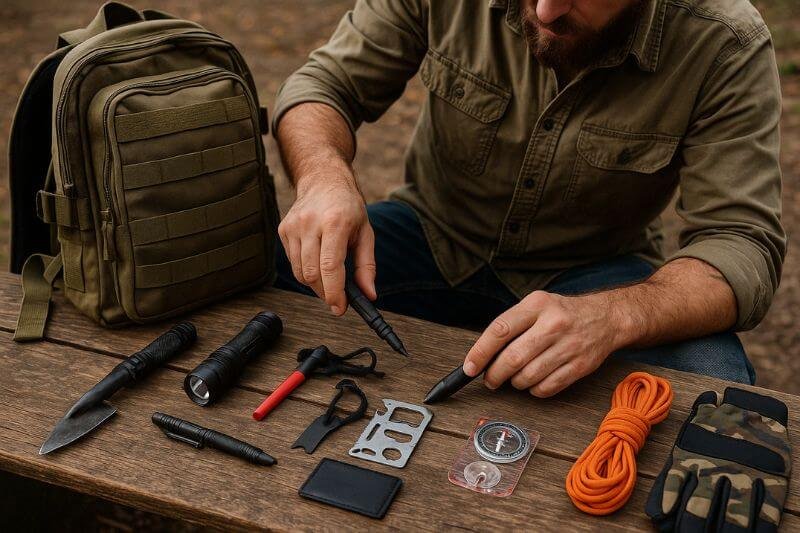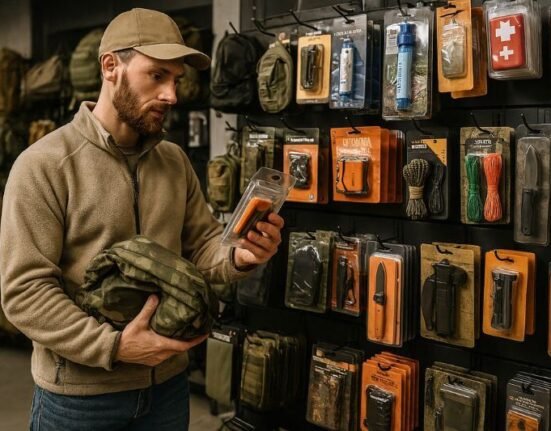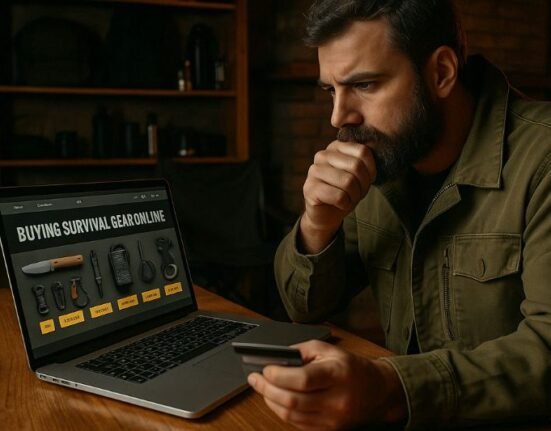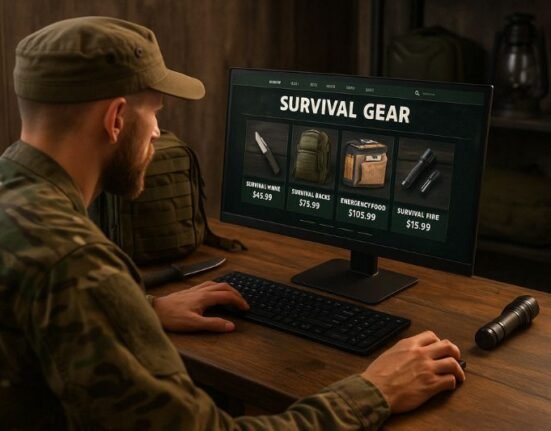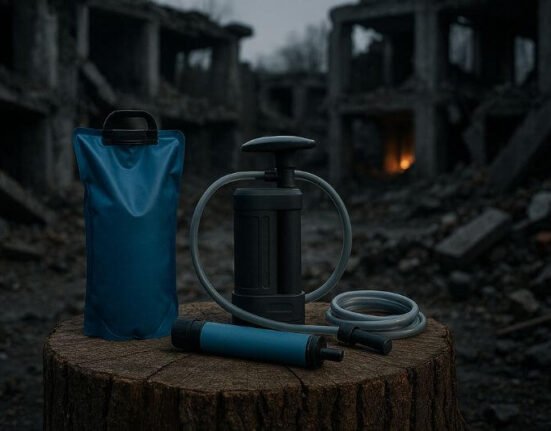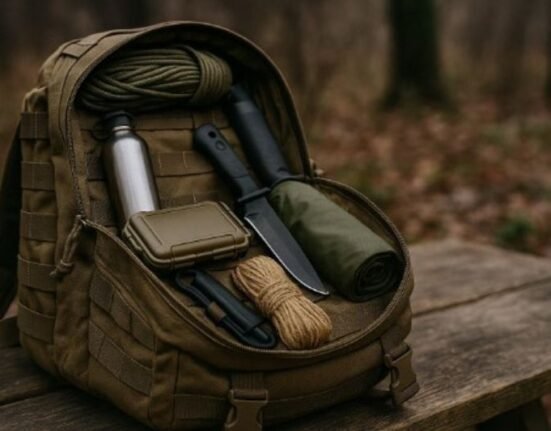In today’s prepping culture, gear is everywhere—on social media, in influencer videos, and across endless “must-have” lists. But not all equipment lives up to its reputation. In fact, some of the worst decisions survivalists make are based on gear that looks good in ads but fails in real crises.
This article exposes the overrated survival items you should avoid, based on real-world lessons and expert feedback. We’ll also explore how hype, branding, and social media distort reality—and what actually matters when your life is on the line.
Because the truth is: bad survival gear can do more harm than good.
The Problem with “Tactical” Gear Culture
The Illusion of Preparedness: Gear ≠ Skill
In the survival world, owning flashy gear isn’t the same as being ready. Many preppers load their bug-out bags with overrated survival items that feel impressive—but don’t hold up under pressure.
Just because something fits in your pocket or looks “tactical” doesn’t make it essential. Some of the most unnecessary prepper tools offer no real utility in harsh conditions. Others are just gimmicks designed for Instagram, not disaster.
A survivalist with a lighter, a water filter, and training will always outlast someone with a bag full of toys.
This illusion of preparedness leads to overconfidence—and in a crisis, that’s dangerous.
The Rise of Influencer Marketing in the Survival Space
Marketing today doesn’t rely on facts—it relies on followers. Many tools promoted online are overrated survival items boosted by sponsored content, affiliate commissions, and TikTok hacks.
These tools may look cool and sell well, but they rarely get tested in the field. Worse, they distract from simple, time-tested gear that works under pressure.
🧠 Survival tip: If you see the same gadget in every viral video, but never in real field gear lists from wildland firefighters, off-grid homesteaders, or combat medics… it’s probably all hype.
Why Some Tools Look Cool but Fail Under Stress
The most dangerous survival gear to avoid are those that seem useful—but fail when it matters. Common traits include:
- Flimsy construction
- Over-complicated design
- Limited functionality in cold, rain, or darkness
- Parts that break under minimal stress
Think about those survival gear myths you’ve seen: paracord bracelets that unravel too quickly, fire-starter rings that never spark, or multitools so small they can’t grip anything.
In real survival, performance trumps presentation. Always.
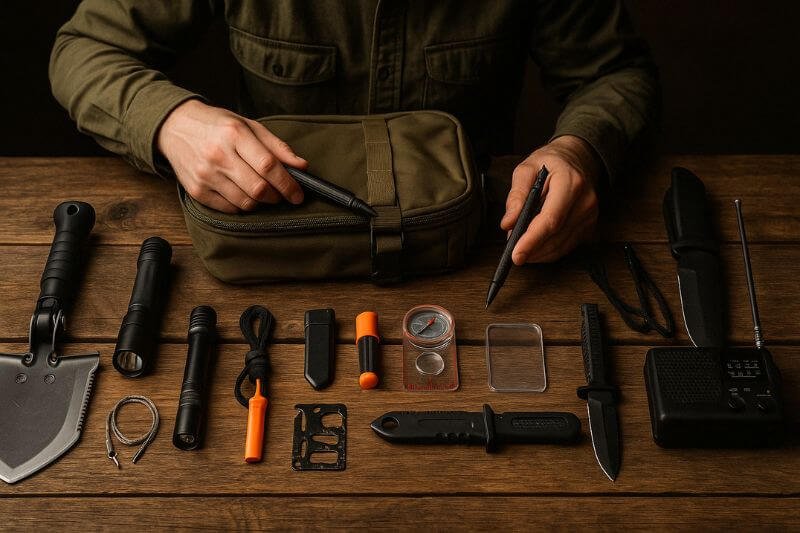
10 Overrated Survival Items (and What to Choose Instead)
Even experienced preppers sometimes fall for flashy tools that offer little value in a real crisis. This section reveals 10 of the most overrated survival items, explains why they often fail, and suggests better alternatives trusted by seasoned survivalists.
Because real preparedness isn’t about how much you carry—it’s about carrying the right things.
Credit Card Multitools
They promise 10+ functions in a flat, wallet-sized piece of metal. In reality, these tools are often flimsy, hard to grip, and nearly useless in an emergency.
❌ Why it’s overrated:
- No leverage
- Blades dull quickly
- Tiny parts break easily
✅ Use instead: A quality multitool (e.g., Leatherman) or fixed-blade knife you can depend on.
Tactical Pens and Glass Breakers
They’re marketed as self-defense tools, glass breakers, and writing instruments in one. But in real scenarios, they’re often just fancy pens.
❌ Why it’s overrated:
- Poor quality tips
- Not effective against laminated auto glass
- No better than a rock in an emergency
✅ Use instead: Keep a real window punch and a knife with solid grip for actual defensive use.
Giant Survival Shovels with 12 Attachments
Some foldable shovels claim to do everything—cut wood, start fires, break ice, dig trenches. But when one tool tries to do it all, it usually does nothing well.
❌ Why it’s overrated:
- Too heavy
- Weak joints or locking mechanisms
- Poor cutting or digging performance
✅ Use instead: A compact entrenching tool or hatchet designed for a single strong purpose.
Fire + Compass + Whistle Gadgets
These “3-in-1” tools are often sold as bug-out must-haves. But the compass is inaccurate, the whistle is weak, and the fire striker wears out quickly.
❌ Why it’s overrated:
- False security
- Components fail under moisture or cold
- Usually made of plastic
✅ Use instead: Separate, high-quality fire starter, real survival whistle, and a proper lens compass.
Cheap Mylar Blankets Marketed as Miracle Shelters
Space blankets do have a place—but not as your main thermal protection. Many people treat them like a substitute for real shelter gear.
❌ Why it’s overrated:
- Tear easily
- Blow away in wind
- No insulation or durability
✅ Use instead: Emergency bivvy sack, wool blanket, or tarp with insulation layer.
Flashlights with Proprietary Batteries
A super-bright flashlight is useless when you can’t charge or replace the battery in the field. This is a common trap in bad survival gear.
❌ Why it’s overrated:
- Requires special batteries
- No solar or manual charge options
- May fail in wet or cold conditions
✅ Use instead: Headlamp or flashlight that runs on AA/AAA or has crank/solar charging.
Water Filters with No Replaceable Parts
Some budget filters work fine at first—but they clog quickly, and you can’t clean or replace the cartridge.
❌ Why it’s overrated:
- Short lifespan
- Can’t backflush or service
- Not safe for long-term use
✅ Use instead: Sawyer Mini, MSR Guardian, or LifeStraw with known performance and replaceable components.
Paracord Bracelets
They look cool, but they offer very little cordage—often less than 8 feet—and are hard to untangle in stress situations.
❌ Why it’s overrated:
- Not enough rope for real tasks
- Difficult to deploy quickly
- Poor knot strength
✅ Use instead: Carry 50 feet of 550 paracord in a zip pouch or wrapped flat.
Low-Quality Multitools with Dozens of Functions
More is not better. Budget multitools with 20+ attachments tend to fail when any real force is applied.
❌ Why it’s overrated:
- Loose joints
- Weak steel
- Many functions unusable in the field
✅ Use instead: One solid multitool with pliers, blade, wire cutter, and screwdriver—nothing more.
Pocket Survival Guides
Tiny booklets seem helpful, but in the moment of panic or darkness, you won’t flip through pages. Especially not ones printed in 6pt font.
❌ Why it’s overrated:
- Too small to read
- Not waterproof
- Rarely consulted under stress
✅ Use instead: Practical experience, laminated cheat sheets, or offline PDFs stored on a solar-charged device.
🧠 Final Thought
The market is flooded with overrated survival items. They sell because they look tactical, promise too much, or ride the wave of fear-based marketing.
But real survival is about function, not flair. Avoid the bad survival gear and survival gear myths. Choose simple, durable tools that have been tested, not hyped.
Comparison Table: Overrated Survival Items vs. Reliable Alternatives
| 🚫 Overrated Item | ❌ Why It’s a Problem | ✅ Trusted Alternative |
|---|---|---|
| Credit Card Multitools | Weak, hard to use, no real leverage | Quality multitool (e.g. Leatherman) |
| Tactical Pens / Glass Breakers | Ineffective in real scenarios, weak glass tips | Real window punch + fixed-blade knife |
| 12-in-1 Survival Shovels | Too heavy, fragile locking joints | Compact entrenching tool or small hatchet |
| Compass/Fire/Whistle Gadgets | Cheap components, unreliable when wet | Separate high-quality tools for each function |
| Cheap Mylar Blankets | Tear easily, no insulation or structure | Emergency bivvy or tarp + wool blanket |
| Flashlights with Proprietary Batteries | Hard to recharge, not reliable off-grid | Solar/crank flashlight with AA/AAA option |
| Non-Replaceable Water Filters | Short lifespan, not field serviceable | Sawyer Mini, LifeStraw, MSR Guardian |
| Paracord Bracelets | Too short, hard to untie in stress | 50ft of 550 paracord in a pouch |
| Low-Quality Multitools | Weak steel, too many useless features | Simple multitool with 5–6 core functions |
| Pocket Survival Guides | Hard to read, impractical under stress | Offline cheat sheets or laminated references |
How to Spot Useless Gear Before You Buy It
When it comes to survival, wasting money—and space—on the wrong gear can cost more than dollars. It can cost you time, energy, and in extreme cases, safety. Avoiding overrated survival items means learning how to evaluate gear before it ever enters your kit.
Here’s how to sharpen your eye and avoid falling for the worst survival gear myths on the market.
3 Golden Rules to Evaluate Gear Usefulness
Before you buy anything, apply these three simple rules:
- Does this item solve a real problem I’ve personally encountered or trained for?
- Can I explain exactly when, where, and how I’d use it under stress?
- Does it replace or duplicate something else I already carry?
If the answer to any of these is unclear, it’s probably one of those unnecessary prepper tools. Don’t buy gear for the idea of survival—buy gear for the reality of it.
Common Red Flags: Reviews, Materials, and Price Traps
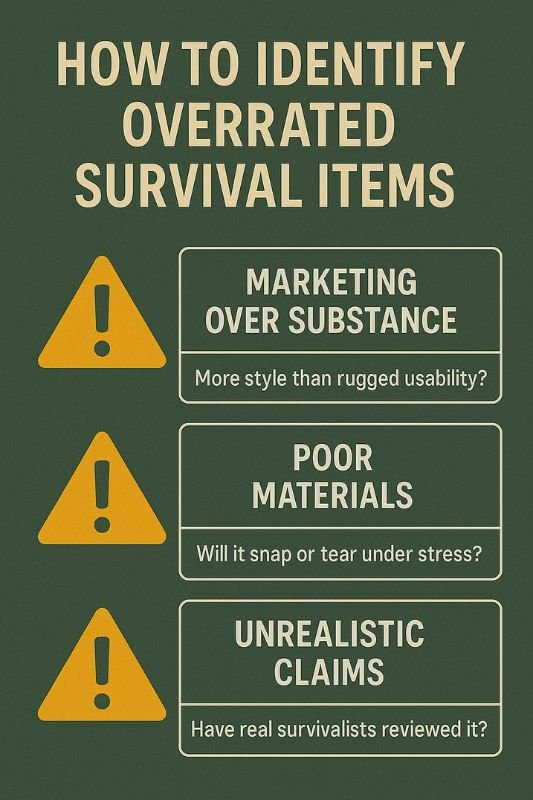
Some tools scream “avoid me”—but only if you know what to look for. Here are the most frequent warning signs of bad survival gear:
- 🔻 Overly positive reviews that don’t describe actual usage
- 🔻 No-name brands with poor-quality photos and no spec sheets
- 🔻 “Military-grade” or “tactical” in the name (with no real testing data)
- 🔻 Prices that seem too low for the claimed features
👉 Example: A multitool claiming 18 tools for under $10? That’s a red flag.
The market is flooded with survival gear to avoid—mass-produced for profit, not performance. Always research beyond the marketing and check for real user tests.
What Real Survivalists Actually Carry
Field-tested gear has nothing to prove. Ask wildland firefighters, bush pilots, or off-grid homesteaders what they carry—and it’s usually boring but bulletproof.
Real survivalists value:
- Simplicity over multifunctionality
- Durability over design
- Manual operation over dependency on tech
The best survival gear doesn’t make you look cool. It saves your life quietly.
When in doubt, trust gear that’s seen action, not gear that’s trending on social media.
The “Earn Its Weight” Principle
Every item in your kit must earn its weight. That means it must do something crucial, reliably, and in more than one situation.
If a tool:
- Only works in fair weather
- Breaks after one drop
- Takes minutes to figure out
- Has never been tested in real conditions
…then it likely falls into the category of overrated survival items.
✅ Replace it with something that’s lighter, tougher, and actually usable under stress. Remember, your bug-out bag is not a gear museum—it’s a tool chest for high-stakes survival.
🧠 Final Insight
Spotting overrated survival items isn’t just about what not to buy—it’s about sharpening your critical thinking as a prepper. Trust function over flair, avoid survival gear myths, and test everything you carry before you ever need it.
Because when the grid fails, your gear can’t.
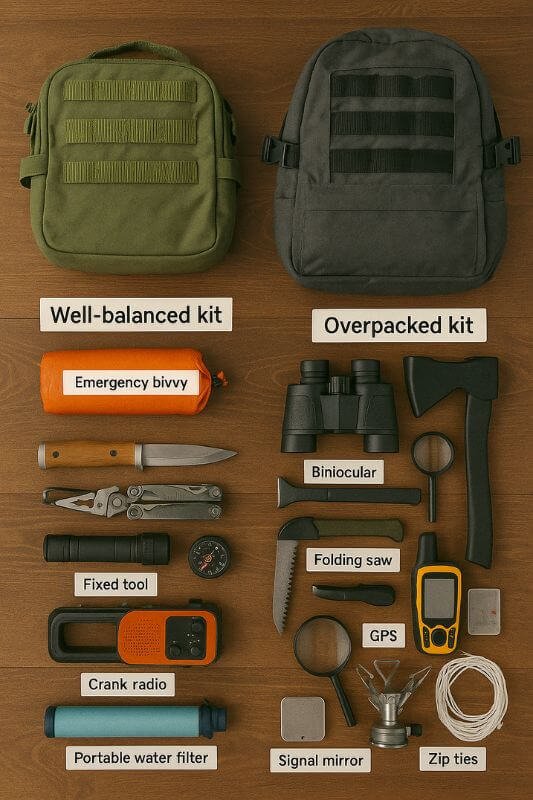
❓ Frequently Asked Questions (FAQ) – Overrated Survival Items
Why are so many survival items overhyped in the first place?
The answer is simple: marketing sells fear. Brands know that in a crisis-driven market, people are willing to spend money quickly—often without much research. Add in social media influencers, affiliate commissions, and flashy branding, and you get a wave of overrated survival items that look amazing in a video… but fail in the field.
Products are often designed to look tactical, not be tactical. And because many buyers are beginners, they trust the hype instead of real experience.
🧠 Tip: Always ask: Has this tool been tested in rain, cold, panic, and fatigue? Or is it just well packaged?
Are expensive tools always better than cheap ones?
Absolutely not. Price doesn’t equal performance in survival gear. Some affordable gear—like the Mora knife or the Sawyer Mini water filter—has proven itself time and time again in real-world use.
On the flip side, some of the most bad survival gear we’ve seen cost upwards of $100 but failed under pressure—due to poor materials, fragile designs, or over-engineering.
What matters more than price is:
- Simplicity
- Durability
- Ease of use under stress
- Multi-condition reliability
If a tool checks those boxes and has been field-tested, it’s worth it—no matter the price tag.
How can I avoid wasting money on survival gear I’ll never use?
Here’s a 3-step checklist to avoid buying unnecessary prepper tools:
- Train first, buy second.
You’ll understand what you actually need once you’ve done a weekend in the woods or a 24-hour power outage simulation. - Build around the Rule of Threes.
Prioritize gear that addresses:- 3 minutes without air
- 3 hours without shelter
- 3 days without water
- 3 weeks without food
- Test everything at home.
Don’t just store gear. Use it. Can you light a fire in the rain? Tune your radio without power? Filter puddle water safely?
Most overrated survival items fall apart when you try these tests.
What’s a better alternative to all-in-one survival gadgets?
Most combo tools (fire starter + compass + whistle + thermometer, etc.) fail because they combine weak versions of tools that should be strong individually.
Instead, think modular:
- Carry a dedicated fire starter (ferro rod or stormproof matches)
- Use a real lens compass (not a plastic one attached to your knife)
- Bring a metal whistle (not a hollow plastic one)
🧠 Better one strong tool per job than five weak ones that fail together.
You’ll carry a bit more weight—but gain 10x the reliability.
Is there a minimalist kit setup that works better than overloaded gear bags?
Yes—and in fact, many seasoned preppers prefer a minimalist, high-performance loadout over a 40-lb tactical museum.
Here’s what works:
- A compact kit that’s scenario-focused, not gear-focused
- Items that serve multiple purposes, but only if they do so effectively
- A core selection of tools that cover fire, water, shelter, light, and medical
✅ Example loadout:
- Ferro rod + lighter + tinder kit
- Fixed-blade knife
- 50ft paracord
- Emergency bivvy
- Crank/solar flashlight-radio combo
- First aid pouch with trauma tools
- Water filter + purification tabs
Everything should be:
- Easy to access
- Easy to repair or replace
- Tested in your local conditions
This avoids the trap of overrated survival items that look impressive but weigh you down and offer little return in a real crisis.









